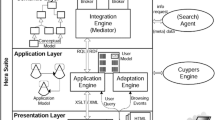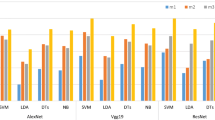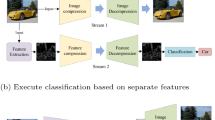Abstract
Aiming at the low accuracy of multimedia visual image cooperative classification, a new method of multimedia visual image cooperative classification based on depth machine learning model is proposed. Firstly, HSV color space model is selected to extract color features of multimedia visual images, Gabor function is used to extract texture features, and shape invariant moments are used to extract shape features. Then the features of multimedia visual images are recognized and classified, and the model parameters are optimized and adjusted according to the deviation of training output. The experimental results show that the average accuracy of this method is 95.892%, and the classification efficiency is high. The classification accuracy of this method is basically above 95%, and the classification accuracy is high. The training time of image type samples is 19 s, the testing time of image type is 12 s, and the time consumption is low.




Similar content being viewed by others
References
Abdelgayed TS, Morsi WG, Sidhu TS (2017) Fault detection and classification based on co-training of semi-supervised machine learning. IEEE Transactions on Industrial Electronics, PP(99):1–1
Ao L, Wu Z, Lu H et al (2018) Collaborative self-regression method with nonlinear feature based on multi-task learning for image classification. IEEE Access, PP (99):1–1
Dao M, Nguyen NH, Nasrabadi NM et al (2016) Collaborative multi-sensor classification via sparsity-based representation. IEEE Trans Signal Process 64(9):2400–2415
Hu XP (2016) Multi-feature fusion image classification based on multi-core learning. Computer Engineering and Applications 52(5):194–198
Imani M, Ghassemian H (2016) Edge patch image-based morphological profiles for classification of multispectral and hyperspectral data. IET Image Process 11(3):164–172
Imani M, Ghassemian H (2017) Edge-preserving-based collaborative representation for spectral-spatial classification. Int J Remote Sens 38(20):5524–5545
Kowsari K, Heidarysafa M, Brown DE et al (2018) RMDL: Random Multimodel Deep Learning for Classification 12(7):65–79
Liu R, Gillies DF (2016) Overfitting in linear feature extraction for classification of high-dimensional image data. Pattern Recogn 53(C):73–86
Liu Z, Song L, Zhao W (2016) Classification of large-scale stellar spectra based on the non-linearly assembling learning machine. Mon Not R Astron Soc 455(4):4289–4294
Lu C, Yan S, Lin Z (2016) Convex sparse spectral clustering: single-view to multi-view. IEEE Trans Image Process 25(6):2833–2843
Mishra M, Rout PK (2018) Detection and classification of micro-grid faults based on hht and machine learning techniques. Iet Generation Transmission & Distribution 12(2):388–397
Murugan P (2018) Implementation of. Deep Convolutional Neural Network in Multi-class Categorical Image Classification 72(1):85–92
Na JH, Chang HJ (2016) Blockwise collaborative representation-based classification via l 2 -norm of query data for accurate face recognition. Electron Lett 52(13):1114–1116
Ran Q, Wei L, Qian D (2018) Kernel one-class weighted sparse representation classification for change detection. Remote Sensing Letters 9(6):597–606
Wang J, Jiao L (2017) Application of a homogenous patch mean kernel with within-class collaborative representation for hyperspectral imagery classification. Remote Sensing Letters 8(1):11–20
Wang X, Yiu SM (2016) A multi-task learning model for malware classification with useful file access pattern from. API call sequence 34(5):133–142
Wang Y, Lin X, Wu L, et al (2017) Effective multi-query expansions: collaborative deep networks based feature learning for robust landmark retrieval. IEEE Transactions on Image Processing, PP(99):1–1
Yeh CK, Wu WC, Ko WJ et al (2017) Learning Deep Latent Spaces for Multi-Label Classification 12(4):513–524
Zhang Y, Yang H (2017) Image classification method based on optimized visual bag model. Computer Application 37(8):2244–2247
Zhao Y, Ding Y, Zhao XY (2016) Image quality assessment based on complementary local feature extraction and quantification. Electron Lett 52(22):1849–1851
Author information
Authors and Affiliations
Corresponding author
Additional information
Publisher’s note
Springer Nature remains neutral with regard to jurisdictional claims in published maps and institutional affiliations.
Rights and permissions
About this article
Cite this article
Yuchi, Sy., Xu, S. Research on cooperative classification of multimedia visual images based on deep machine learning model. Multimed Tools Appl 80, 22657–22670 (2021). https://doi.org/10.1007/s11042-019-7637-x
Received:
Revised:
Accepted:
Published:
Issue Date:
DOI: https://doi.org/10.1007/s11042-019-7637-x




